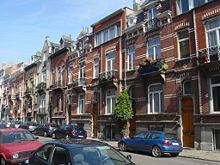Area codes 02 Local time Wednesday 5:48 PM | Region Brussels Postal codes 1040 Postal code 1040 | |
 | ||
Community Flemish CommunityFrench Community Weather 11°C, Wind W at 23 km/h, 94% Humidity Points of interest Cinquantenaire Museum, Royal Museum of the Arme, Cauchie House, Brussels Greeters, Jean‑Felix Hap Garden | ||
Etterbeek (French: [ɛtəʁˈbek]; Dutch: [ˈɛtərˌbeːk]) is one of the nineteen municipalities located in the Brussels-Capital Region of Belgium. It neighbours the municipalities of the City of Brussels, Ixelles, Auderghem, Woluwe-Saint-Pierre, Woluwe-Saint-Lambert and Schaerbeek.
Contents
- Map of 1040 Etterbeek Belgium
- Origins and etymology
- Middle Ages
- Barony and municipality
- Places of interest
- Transportation
- Sports
- Proposed redevelopment Les Jardins de la Chasse
- Events
- Notable residents
- International relations
- References
Map of 1040 Etterbeek, Belgium
The main university campus of Vrije Universiteit Brussel is called Campus Etterbeek, although it is geographically not within Etterbeek but in the adjacent municipality of Ixelles.
Origins and etymology
According to legend, Gertrude, daughter of Pippin of Landen, founded a chapel here in the 8th century. A document by Otto I, dated 966, mentions the church of Iatrebache. The name Ietrebecca – possibly from the Celtic root ett meaning "rapid movement" and the Dutch word beek meaning "stream" – is found for the first time in a document dated 1127. The current spelling appears eleven years later in 1138, around which time a newer and larger church was built.
Middle Ages
In the Middle Ages, Etterbeek was a rural hamlet mostly independent of Brussels, aside from taxation rights on beer given to Brussels around 1300 by John II, Duke of Brabant. The following two centuries counted several grievous moments: in 1489, Albert, Duke of Saxe ravaged Etterbeek in his pursuit of the rebels who fought against Maximilian of Austria; in 1580, the village is destroyed once more, this time by the iconoclasts during the Protestant Reformation wars. Peace came back under the reigns of Archdukes Albert and Isabella.
Barony and municipality
In 1673, Etterbeek gained its independence from neighbouring Sint-Genesius-Rode, when Charles II of Spain promoted it into a barony. The first baron was Don Diego-Henriquez de Castro, general treasurer of the Netherlands armies. The Castro house was sold in 1767 and can still be seen today as Etterbeek's oldest building.
Under the French regime, Etterbeek was made into a commune, within the canton of Sint-Stevens-Woluwe. From then on, and especially after the Belgian Revolution of 1830 and the development of Brussels as a capital city, the population of Etterbeek grew quickly. In 1876, there were more than 10,000 inhabitants, in 1900 more than 20,000, and in 1910 more than 33,000. In the 1900s (decade), under the reign of Leopold II, construction boomed and changed the town's character with the addition of the broad avenues and residential areas that we know today.
Places of interest
Transportation
There is a rail station called Gare d'Etterbeek or Etterbeek-Station but, like the neighbouring campus of the Vrije Universiteit Brussel, it is also located in Ixelles or Elsene. Presently, Etterbeek has one rail station (Mérode) and three metro stations (Mérode, Thieffry and Pétillon).
Sports
Proposed redevelopment "Les Jardins de la Chasse"
A project is currently proposed to redevelop an area of Etterbeek near the Avenue des Casernes. This project would result in the town hall and police station being relocated to new buildings in a central administrative centre on this site. The new site is being called the Jardins de la Chasse (French) or Tuinen van de Jacht (Dutch). Demolition of the former CPAS building on the site started in 2014, and building of houses on the site started in 2016, with construction of the new town hall awaiting administrative approval. Municipal offices are forecast to move to the new location in summer 2018. The site of the current town hall may in the future be used for further residential development.
Events
Etterbeek hosts an annual medieval market. Previously held at the end of May on the Avenue du 2ème Régiment de Lanciers in the south of the municipality, in recent years it has taken place in Cinquantenaire.
Notable residents
Born in Etterbeek:
Lived part of their life in Etterbeek:
Buried in Etterbeek:
International relations
Etterbeek is twinned with:
